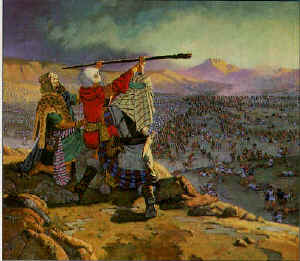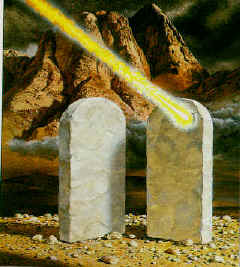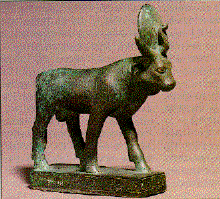The Torah: Exodus: Birth of a Nation
Israel in Egypt Chapters 1:1-12:36
Setting the scene: chapter 1
Exodus opens with a list of “the sons of Israel” (verse 1) who were the focus of the last part of Genesis. The attention shifts quickly in verse 7 to the “Israelites” (people of Israel). From this point on, the name Israel usually refers to the nation of people, not to the patriarch.
Jacob’s descendants had been “fruitful and multiplied greatly and became exceedingly numerous, so that the land was filled with them” (verse 7). By this time, a new pharaoh ruled over Egypt who did not honor the friendship that once existed between the Egyptian rulers and the family of Joseph. This pharaoh feared that the Israelites might become powerful enough to challenge his authority, so he began to oppress them.
But no matter how much Pharaoh exploited the Israelites and how hard he worked them, their numbers continued to grow. As the Israelites multiplied, Pharaoh began to see them as more than just a labor pool. He became concerned that this large alien population would organize and pose a threat to Egypt. Pharaoh decided to tackle the problem in a more cruel way, only to be defeated by the faith and courage of the Hebrew midwives (verses 15-21).
Moses: prince and alien: chapter 2
Pharaoh decreed that all Hebrew baby boys were to be drowned in the Nile River (Exodus 1:22). Moses’ life was saved by his mother’s resourceful action. She placed him in a watertight basket (the same Hebrew word, tebhah, used for Noah’s “ark”) and set it adrift in the river. Moses was later rescued by Pharaoh’s daughter.
As a child growing up in the palace, Moses would have received a traditional Egyptian education, learning to read and write the Egyptian hieroglyphics and cursive scripts. As he matured, he would have gained expertise in military, religious and political affairs (Acts 7:22). It was not unknown for foreigners to be trained in this manner for responsible posts in the army, priesthood or civil service.
At age 40, Moses came to the defense of a fellow Israelite, and he killed an Egyptian taskmaster. Consequently, he was forced to flee into exile (Exodus 2:11-15; Acts 7:23-29). It has been said that Moses spent 40 years in Egypt learning to be somebody, and 40 years in Midian learning to be nobody, and this prepared him for the mighty task of delivering the children of Israel.
 |
These wall paintings are from the tomb of Rekhmere, an Egyptian nobleman of the mid-second millennium B.C. They depict Egyptian laborers preparing clay bricks. Such images are reminiscent of Pharaoh’s orders in Exodus 5:6-8. |
 |
|
The burning bush: chapters 3-4
“Now Moses was tending the flock of Jethro his father-in-law, the priest of Midian, and he led the flock to the far side of the desert and came to Horeb, the mountain of God. There the angel of the Lord appeared to him in flames of fire from within a bush” (Exodus 3:1-2). Moses was at Mt. Sinai (Horeb), the place where God later gave the Ten Commandments to Israel (Exodus 19 20). God had a great commission for Moses. He was to be God’s messenger to Pharaoh, and lead the Israelites to freedom. However, Moses was extremely reluctant. He raised one objection after another, but each was countered by God.
Throughout the burning-bush incident, Moses showed a profound reverence for the presence of God. He realized how unworthy he was to stand before his Creator. As we study this account, we should reflect on our own attitude and approach to God. One thing that did not please God, however, was Moses’ resistance to his special calling. Moses wanted God to find a better man, but God promised to help him fulfill his commission. Similarly, God promises to be with us today: “Being confident of this, that he who began a good work in you will carry it on to completion until the day of Christ Jesus” (Philippians 1:6).
 |
|
 |
Startled perhaps by the cries of the baby Moses, who was found among a thicket of bulrushes by Pharaoh’s daughter, an ibis takes flight in this depiction by Frederick Dillon (top). The coiled reed basket (left) is typical of those used in ancient Egypt. |
Objections of Moses |
|
| Moses’ objections | God’s answers |
| “Who am I, that I should go to Pharaoh…?” | God answered,”I will be with you” (Exodus 3:11-12). |
| “Suppose I go to the Israelites and say to them, `The God of your fathers has sent me to you,’ and they ask me, `What is his name?’ Then what shall I tell them?” | God revealed himself as the God of their ancestors, and God of the present: “I AM WHO I AM” (verses 13-14). |
| “What if they do not believe me or listen to me…?” | God gave him three signs with which to convince them (Exodus 4:1-9). |
| “I have never been eloquent…. I am slow of speech and tongue.” | God promised to teach him what he should say (verses 10-12). |
| “O Lord, please send someone else to do it.” | God countered, not by replacing Moses, but by sending Aaron with Moses as a spokesman(verses 13-16). |
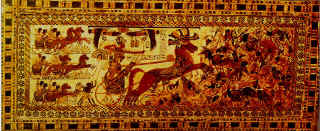 |
| Egyptian war chariots, like the ones used against Israel, are shown here on “The Painted Box from the tomb of King Tutankhamen (14th century B.C.). This view shows Tutankhamen in battle against the Syrians. |
Pharaoh wins round one: chapters 5:1–6:13
God instructed Israel to leave Egypt in order to worship him. Pharaoh’s reaction revealed his rigid hostility, already predicted by God (Exodus 3:19). “Egyptian hieroglyphics pictured the word for foreigner as a bound man with blood flowing from a wound in his head; the Israelites felt the full weight of such oppression” (The New Student Bible, NIV, commentary on Exodus 6:9). Moses’ request to Pharaoh only made life harder for the Israelites. They blamed Moses for their trouble, and Moses pleaded with God for deliverance once again.
The family tree of Moses and Aaron: chapter 6:14–27
As is often the case in Scripture, this family record is selective. Moses and Aaron are shown to have descended from Jacob through the line of Levi. The list covers the period of Israel’s stay in Egypt. This biblical genealogy more firmly identifies Moses and Aaron. As well as outlining the history of a family, genealogies were used to establish family credentials and authority.
The contest with Pharaoh: chapters 6:28–12:36
Pharaoh again rejected Moses’ request. The Egyptian ruler had already shown what sort of person he was: “I do not know the Lord and I will not let Israel go” (Exodus 5:2). Pharaoh was not concerned about Moses’ message, for he had not yet seen any evidence of God’s power. So God initiated a series of judgments to teach Pharaoh and his people who the Lord was, and to show them the extent of his sovereign power over all creation (Exodus 7:5).
The 10 plagues convinced the Egyptians, and the surrounding nations, of the power of the God of Israel. After the death of Egypt’s firstborn, Pharaoh ordered the Israelites to leave the country immediately (Exodus 11:1-6; 12:29-36). For Israel, this day when God saved his people was to be remembered throughout the ages. The Passover festival was instituted to commemorate the day. The blood of the Passover lamb symbolized God’s protection and mercy for his people, Israel, as his firstborn (Exodus 4:21-23; 12:1-14, 21-28). This foreshadowed the sacrifice of “Christ, our Passover lamb” (1 Corinthians 5:7).
The Ten Plagues |
| 1) The Nile River turned to blood. Its polluted water killed the fish (7:14-24).
2) Seven days later, frogs, driven from the riverbanks by the rotting fish, sought shelter in the houses (7:25; 8:1-15). 3-4) Gnats, and then flies, breeding among the carcasses of fish and frogs, plagued the land (8:16-32). 5-6) Disease struck the cattle, and skin infections, perhaps carried by the frogs and insects, broke out on humans and animals (9:1-12). 7) Hail and thunderstorms ruined the flax and barley crops. Those Egyptians who heeded God’s warning remained safe (9:13-35). 8) The wind blew in a plague of locusts, which stripped the country bare of any remaining vegetation (10:1-20). 9) For three days, the light of the sun was blotted out by total darkness (10:21-29). 10) Egyptian firstborn sons died. So did the firstborn of all livestock (11:1-12:30). |
From Egypt to Sinai: Exodus 12:37–19:25
Crossing the Red Sea: chapters 12:37–14:31
After centuries of living in a foreign land, the Israelites were free. This is what God had promised their father Abraham (Genesis 15:13-14). Before starting their journey to the border, God gave further instructions about how the Passover was to be observed. In this “dedication ceremony” of the Exodus, God announced how this great event was to be further commemorated. For seven days after the Passover, the Israelites were to eat unleavened bread as a reminder of their quick departure from Egypt. “You must keep this ordinance…year after year” (Exodus 13:6-10).
God then led his people “around by the desert road toward the Red Sea,” going before them in a pillar of cloud by day and a pillar of fire by night (verses 17-22).
Meanwhile, Pharaoh had changed his mind about letting the Israelites leave. He and his army set out to recapture them. The sight of Pharaoh’s army filled the people with fear. But Israel soon learned the lesson of Moses’ words: “The Egyptians you see today you will never see again. The Lord will fight for you; you need only to be still” (Exodus 14:13-14). God parted the waters of the Red Sea so the Israelites could cross safely. The returning walls of rushing water crushed Pharaoh’s forces.
The crossing of the Red Sea foreshadows Christian baptism: “Our forefathers…all passed through the sea. They were all baptized into Moses in the cloud and in the sea” (1 Corinthians 10:1-2).
The exodus from Egypt was the defining event in the history of ancient Israel. As Eugene H. Merrill points out:
The choice of Israel as a servant people was already implicit in the patriarchal covenant statements (Gen. 12:1-3; 15:13-21; 18:18; 22:18; 26:3-4; etc.), but not until the Exodus deliverance did the nation as such come into historical existence. The Exodus, therefore, is of utmost theological importance as an act of God marking out a decisive moment in Israel’s history, an event marking her transition from a people to a nation (“A Theology of the Pentateuch,” in A Biblical Theology of the Old Testament, ed. Roy B. Zuck, pp. 30-31).
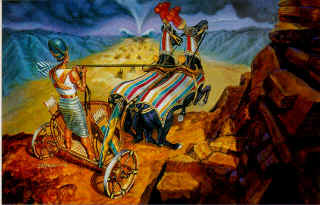
“Moses stretched out his hand over the sea, and at daybreak the sea went back to its place. The Egyptians were fleeing toward it, and the Lord swept them into the sea. The water flowed back and covered the chariots and horsemen – the entire army of Pharaoh that had followed the Israelites into the sea. Not one of them survived” (Exodus 14:27-28). |
The Song of Moses and Miriam: chapter 15:1–21
This is one of the oldest songs recorded in the Bible. As a hymn of victory, it celebrated God’s miraculous triumph over the Egyptian army. Not only did the Israelites remember God’s past deliverance, they anticipated his future blessings (verses 13-18).
The people complain, but God provides: chapters 15:22–17:7
It was not long before the people started to complain. In Egypt, there had been an abundance of fish, fruit and vegetables, and no shortage of water. But in the Desert of Sinai, the people were soon hungry and thirsty (Exodus 15:22-27; 16:1-36).
God gave them manna, a substance that would become Israel’s main food for 40 years. Manna probably means “what is it?” recalling the Israelites’ first reaction to it (Exodus 16:15). God’s method of provision was designed to teach them obedience and daily dependence upon him. It illustrates humanity’s need for God’s love and provision (John 6:25-35; Revelation 2:17).
At Rephidim (Exodus 17:1), the people complained again. This time the water was undrinkable. Moses interceded on their behalf and God worked another miracle. New Testament writers regarded the smitten rock as a symbol of Jesus Christ. He is the source of the water of life: ever fresh, pure abundant, accessible and unfailing (John 7:37-39; 1 Corinthians 10:4).
|
|
| “As long as Moses held up his hands, the Israelites were winning, but whenever he lowered his hands, the Amalekites were winning. When Moses’ hands grew tired, they took a stone and put it under him and he sat on it. Aaron and Hur held his hands up – one on one side, one on the other – so that his hands remained steady till sunset. So Joshua overcame the Amalekite army with the sword” (Exodus 17:11-13). |
Fighting the Amalekites: chapter 17:8–16
Joshua led the Israelite army against the Amalekites, descendants of Esau. But it was God who gave the victory, through Moses’ intercession. In fighting against God’s people, Amalek was really fighting against God.
Jethro’s advice: chapter 18
Jethro, who was Moses’ father-in-law, dominates this chapter. He recognized God’s power (verses 1, 9-10), God’s supremacy (verse 11), God’s presence (verse 12), God’s righteousness (verse 21) and God’s will (verses 19, 23).
Jethro’s wise counsel is worthy of note. He saw the heavy strain on Moses, who was not delegating authority. Jethro advised him to appoint associates as judges. Moses accepted the advice of his father-in-law, and selected men of character and ability.
The qualifications for these men (v. 21) were that they should be (1) “capable men” (i.e., men with a native aptitude for judging), (2) “men who fear [in reverence and belief] God,” (3) men of truth (i.e., “trustworthy”), and (4) men who hated all “dishonest gain.”… Notice that some of the same qualities are expected of leaders in the church (Acts 6:3; 1 Tim 3:2-12; Titus 1:7-9). (The Expositor’s Bible Commentary, vol. 2, pp. 413-414)
The camp at Sinai: chapter 19
Through Moses, God, as he promised earlier (Exodus 3:12), brought Israel to Mt. Sinai, where he now would establish his covenant with the nation. Thunder, lightning, trumpets and smoke heralded God’s presence and demonstrated his awesome power (Exodus 20:18-20 explains why). God told Moses that the Israelites were to be his special representatives. As the high priest represented Israel to God (Hebrews 5:1), the Israelites were to be “priests” to the surrounding nations (Exodus 19:3-6). For Christians, Hebrews 12:18-25 contrasts Mt. Sinai with Mt. Zion, the physical with the spiritual.
Law and Covenant: Exodus 20–27
The Ten Commandments: chapter 20:1–21
The law of Moses was a system of divinely inspired precepts that, in letter and in spirit, defined sin and regulated the Israelites’ conduct. The first four commandments concerned their relationship with God; the remaining six, their relationship with one another. Jesus explained this two-clause summary of the law in Matthew 22:37-40.
|
|
| “The writing was the writing of God, engraved on the tablets” (Exodus 32:16). |
The commandments show God’s concern for the whole of life. He set out rules and standards governing family relationships, regard for human life, sex, property, speech and thought. The Ten Commandments are the Maker’s instructions on how the Israelites were to live a life of service to God and their fellow citizens.
Jesus Christ fulfilled the law of Moses and revealed its spiritual intent. He said, “Do not think that I came to destroy the Law…. I did not come to destroy but to fulfill” (Matthew 5:17, NKJV).
The law was in effect until Christ came as the fulfillment of the promises God gave Israel. “What, then, was the purpose of the law? It was added because of transgressions until the Seed to whom the promise referred had come” (Galatians 3:19). Christians live by faith in the Son of God and walk according to the law of Christ (1 Corinthians 9:21). “Now that faith has come, we are no longer under the supervision of the law” (Galatians 3:25). For further information, see the chapter below on the Ten Commandments.
God’s law code: chapters 20:22–24:18
In this section of Scripture, we are introduced to “the Book of the Covenant” (Exodus 24:7), with its record of civil, social and religious legislation. It is the oldest record we have of Hebrew law. It gives us a detailed account of Israel’s duty to God and neighbor. As we deal with others, we should keep the principle of these laws in mind. This section addresses worship, civil laws, festivals and God’s faithfulness.
Civil, Social and Religious Law |
|
Unique Law Code |
Although the Book of the Covenant is similar to other ancient law codes, it is very different in four important ways.
|
Israel’s agreement to the covenant was formally sealed by burnt offerings and fellowship offerings (Exodus 24:5). Moses then read from the Book of the Covenant. The blood sprinkled on the altar and on the people bound the Israelites to their agreement with God (verses 6-8). The symbolism of blood is prominent in this chapter. It represents the surrender of life to God. The covenant made at Sinai is now obsolete (Hebrews 8:13), replaced by the new covenant in Jesus Christ.
Making the Tabernacle: chapters 25–27
God set out the terms of his covenant, and the Israelites had agreed to obey (Exodus 24:3). As a visible sign that he would always be with his people, God gave Moses instructions to build a special tabernacle, or tent – a portable sanctuary. God was to have a home amongst the Israelites. He would guide and accompany them wherever they went. They would know that he was no local god, whose power was limited to Sinai (adapted from Eerdmans’ Handbook to the Bible, p. 166).
Ark, table and lampstand: chapter 25:10–40
Verses 10-22: The ark: This box, 3.75 feet long, 2.25 feet wide and 2.25 feet high, was made of acacia wood overlaid with gold. It contained a jar of manna, Aaron’s staff that budded and the stone tablets on which the Ten Commandments were written (Hebrews 9:4).
The “mercy seat” (NKJV), the golden lid of the ark, illustrated how God’s throne was not only a throne of judgment, but one of grace (Leviticus 16:2-16). Over the mercy seat two golden cherubim stood facing each other (Exodus 25:20).
Verses 23-30: The table for the “shewbread” (NKJV): Made of acacia wood, it was 3 feet long, 2¼ feet high and 1½ feet wide, and overlaid with gold. Upon it was placed the 12 loaves of bread. The bread was renewed every Sabbath and was eaten by the priests only. This bread typified Jesus Christ, the Bread of Life. It is Christ, our High Priest, who nourishes Christians (Matthew 4:4; John 6:33-58).
Verses 31-40: The golden lampstand: The seven-branched lampstand (Hebrew: menorah), a symbol of life and light, pointed to God as the source of Israel’s blessings (compare Job 29:2-3 with Jeremiah 25:10).
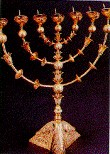 |
  |
| God-centered Religion: “The general truth expressed by the tabernacle, then, is that the Lord determined to live among his people and the will of God — what he wants — equally governs the whole plan of the great tent and its construction. From 25:10 onwards the description moves from the inside to the outside: first the furnishings, the ark, table and lampstand (25:10-40), then the tent-covering (26:1-37), then beyond it to the altar and the court (27:1-19)…. | |
| “One might reasonably have expected that the ‘building’ would come first and then the things it housed. But this would have been to start from the visible, and the whole tabernacle exists as the necessary ‘wrapping’ for the invisible God when he comes down to be with his people. God and his nature determines all, not man and his needs. In this way the tabernacle sums up a basic biblical truth about religion: it must conform to the will and nature of God. Much in the Bible exists to expose man’s tendency to make religion suit his own pleasure, or (as might be said) match what he finds ‘helpful’. But if religion does not match the will of God it is ultimately futile (see, for example, Isaiah 29:13)” (Eerdmans’ Handbook to the Bible, eds. David Alexander and Pat Alexander, William B. Eerdmans Publishing Company, 1973, p. 168). | |
The general construction of the tabernacle: chapter 26
Verses 1-6: The 10 linen curtains: These were made of fine linen, and blue, purple and scarlet yarn, with artistic designs of cherubim embroidered into them.
Verses 7-37: The tabernacle coverings, frames, curtain (“veil,” NKJV) and outer curtain: The veil of the tabernacle separated the Holy Place from the Most Holy Place, the inner sanctuary where the ark of the covenant was located. The veil represents humanity’s separation from the presence of God, which ended when Christ was crucified. At the moment of Christ’s death, the veil was “torn in two from top to bottom” (Matthew 27:51). Although the Old Testament high priest could go behind the veil only once a year, Christ, as our High Priest (Hebrews 9:11-12), provides continual access to the presence of God to everyone who enters “by a new and living way opened for us through the curtain [veil], that is, his body” (Hebrews 10:20).
The bronze altar and courtyard: chapter 27
Verses 1-8: The bronze altar: This was the great altar for animal sacrifices. It was 7.5 feet square and 4.5 feet high. It was located at the entrance of the tabernacle, thus signifying that the shedding of blood is central to humanity’s approach to God. The altar typifies the cross, and the burnt offerings made on it typify Christ, who offered himself unblemished to God (Exodus 12:5; Hebrews 9:14; 1 Peter 1:19).
Verses 9-19: The courtyard: The curtains of fine linen surrounding the courtyard demonstrate that righteousness is required for true worship (Revelation 19:8). They prevent access to anyone who does not come in by the entrance. The entrance of the tabernacle represents Jesus Christ. As our “gate,” he is our access to God by virtue of his redemptive work (John 10:7-9).
Verses 20-21: The oil for light: The fine olive oil symbolizes the Holy Spirit (1 Samuel 16:13).
Priestly Worship: chapters 28:1 – 31:11
The priesthood: chapter 28

Verses 1-5: Aaron, the high priest, typifies Christ (Hebrews 9). Aaron’s holy garments for “dignity and honor” (Exodus 28:2) represent the glory and beauty of Christ as our High Priest.
Verses 6-14: The ephod was an apron-like garment worn under the high priest’s breast-piece. It had shoulder straps and an embroidered waistband, and was worn over a robe. On top of each of the shoulder pieces was an onyx stone encased in gold and engraved with the names of six tribes of Israel.
Verses 15-29: The breast-piece was embellished with precious stones engraved with the names of the tribes of Israel. When Aaron wore this into the Holy Place, it foreshadowed Christ bearing the names of Christians in God’s presence (Romans 8:34).
Verse 30: Mystery surrounds the purpose of Urim and Thummim, meaning “Lights and Perfections.” They were used to ascertain God’s will on special occasions (Ezra 2:63). They were closely associated with the breast-piece of judgment and suggest the guidance of the Holy Spirit.
Verses 31-35: Robe of the ephod: The bells on the hem of the robe spoke of God’s acceptance of the priestly sacrifice. As long as the people heard the tinkling of the bells, they knew that the high priest was still alive in the Most Holy Place. This meant that God was satisfied with their sacrifice.
Verses 36-38: The gold head-plate was inscribed with the words, “Holy to the Lord,” analogous to the holiness and purity of Christ’s priesthood (Hebrews 7:26).
Verses 39-43: Underneath the special high priestly regalia, Aaron wore the same vestments as the regular priests. This indicated that the dignity and honor that characterized Aaron (typifying Christ — Hebrews 4:14) also characterized his sons (typifying Christians in this age — 1 Peter 2:9). The linen undergarments (Exodus 28:42) typify the righteousness of Christ imputed to the believer (Revelation 19:7-8).
Priestly rituals: chapter 29
Articles about Exodus in “Exploring the Word of God” |
Verses 1-4: The washing: This cleansing in water, in which Aaron participated because he was a sinner, symbolizes our “rebirth and renewal” (Titus 3:5; John 3:5). Christ, as our “holy, blameless, pure” High Priest (Hebrews 7:26-28), did not need to be cleansed. Nevertheless, he yielded to John’s baptism in the Jordan to identify himself with sinners and fulfill the Old Testament prophecies (Matthew 3:13-17).
Verses 5-25: The clothing and anointing: Aaron was clothed with splendid garments. His anointing was symbolic of “the Spirit of God descending” on Christ (Matthew 3:16; Acts 10:38). Aaron alone was anointed before the blood was shed (the consecration of the priests required various offerings in which the shedding of animal blood took place). This sets Aaron apart as a striking picture of Christ, who was anointed as God in the flesh and lived a sinless life. Christ did not need to be redeemed as we do.
Verses 26-46: Special food for priests: This was fitting for those who represented the people before God in sacrifice and worship.
Worship and the altar of incense: chapter 30
Verses 1-10: The altar of incense was made of acacia wood overlaid with gold; it was 11.5 feet square and 3 feet high. Equipped with horns and poles for transporting it, the altar was located in the Holy Place in front of the curtain. Aaron offered incense twice daily. The incense symbolizes prayer, which, like an ascending sweet aroma, rises acceptably to heaven (Revelation 5:8; 8:3). No “other incense” (Hebrew: qetoreth zarah, meaning “incense that is strange or foreign to the law”) was to be used (Exodus 30:9).
Verses 11-16: The atonement money: True worshipers had to be redeemed. All adults in any national census were on an equal footing — all needed redemption — shown by the payment of the half shekel.
Verses 17-21: The bronze basin: This washbasin was used by the priests to cleanse their hands and feet. It is symbolic of the washing of water through the Word (Hebrews 10:22; Ephesians 5:25-27; John 13:3-10). As Christians, we, too, must be continually cleansed and purified from sin (1 John 1:9).
Verses 22-33: The anointing oil is a symbol of the Holy Spirit. Only those who have been cleansed (forgiven) can properly worship God (John 4:23; Ephesians 2:18).
Verses 34-38: The incense: The ingredients are listed, as in the case of the anointing oil. Once again, only those redeemed (Exodus 30:11-16), cleansed (verses 17-21) and anointed (verses 22-33) can truly worship God.
God chooses his workmen: chapter 31:1–11
This chapter shows that when God selects men and women for a particular job, he also equips them to do it. Verse 3 is one of the earliest references in the Bible to the guiding work of the Spirit of God.
Law and Covenant: Exodus 31:12–40:38
The Sabbath: chapter 31:12–18
The Sabbath was an appointed day of rest and worship. It was a memorial of the seventh day of creation, when God rested from his work. The observance of the Sabbath was included in the Ten Commandments, and was a sign between God and his people Israel (Genesis 2:2-3; Exodus 20:8-11; 31:17). It pictured a future reality — sharing in the rest of God through faith in Christ (Hebrews 4).
|
|
| The bronze figure is of Apis, the bull-god of Memphis, in lower Egypt. It may be that the cult of this and other sacred bulls in Egypt influenced the Israelites in their decision to worship a golden calf (Exodus 32:2-4). The only other biblical example of this type of idolatry is when King Jeroboam installed two golden calves in his new sanctuaries (1 Kings 12:28-30). |
Unfortunately, only six weeks after pledging their allegiance to God, the children of Israel demanded a replica of one of the gods of ancient Egypt. The impatience of the people was matched by the weakness of Aaron, the high priest. Not only did he preside over the making of the calf, but he also identified it with the true God of Israel!
Moses’ indignation is understandable. In breaking the tablets of stone, he dramatically proclaimed Israel’s breaking of the covenant. Only his intervention saved the people from annihilation. Nevertheless, God punished them for their sin (verses 25-28).
Moses sees the glory of God: chapter 33
God’s punishment brought results. The Israelites discarded their personal idols. Moses, though, was still concerned. He wanted to ensure that God had restored favor to his people, so he asked for a bigger sign than in the past. Moses was permitted to see a glimpse of God’s glory (verses 18-23).
The covenant renewed: chapter 34
God renewed his covenant by engraving the law on a new set of stone tablets. This renewal of the covenant gave additional guidelines resulting from Israel’s worship of the golden calf, as well as warnings about the coming temptations of the Canaanite religion. For example, the Israelites were not to follow the Canaanite practice of cooking a young goat in its mother’s milk (verse 26). God also reiterated the Sabbath and three annual festivals (verses 18-22).
Setting up the tabernacle: chapters 35–40
These chapters explain how the instructions God gave earlier (Exodus 25–31) were to be carried out. The people contributed gifts to the tabernacle. Their response was so enthusiastic and generous that Moses asked them to stop giving.
This illustrates an important spiritual principle that you will often see as you study the Bible. Giving should always be done willingly and proportionate to one’s blessings (2 Corinthians 9:7). The act of giving imitates God’s grace to us. As Jesus told his disciples, “Where your treasure is, there your heart will be also” (Matthew 6:21).
When the tabernacle was finished, God filled it with his glory. In the New Testament, God “tabernacled” among his people in the form of Jesus Christ and they witnessed his glory (John 1:14 uses the Greek word for “live in a tent”).


